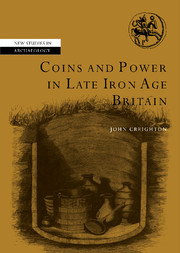Book contents
- Frontmatter
- Contents
- List of figures
- List of tables
- Preface
- Acknowledgements
- List of abbreviations
- Note on translations used
- Introduction
- 1 The Middle to Late Iron Age transition
- 2 Coin and the representation of individual authority
- 3 The Southern and Eastern kingdoms
- 4 Classical imagery and ideology in Britain
- 5 The location of Britain in the Roman world
- 6 Legends and language
- 7 Dynasties and identities
- 8 Conclusion and epilogue: from Britain to Britannia
- Appendix: A brief introduction to Iron Age coinage in Britain
- References
- Index of coin types
- General index
- NEW STUDIES IN ARCHAEOLOGY
1 - The Middle to Late Iron Age transition
Published online by Cambridge University Press: 22 September 2009
- Frontmatter
- Contents
- List of figures
- List of tables
- Preface
- Acknowledgements
- List of abbreviations
- Note on translations used
- Introduction
- 1 The Middle to Late Iron Age transition
- 2 Coin and the representation of individual authority
- 3 The Southern and Eastern kingdoms
- 4 Classical imagery and ideology in Britain
- 5 The location of Britain in the Roman world
- 6 Legends and language
- 7 Dynasties and identities
- 8 Conclusion and epilogue: from Britain to Britannia
- Appendix: A brief introduction to Iron Age coinage in Britain
- References
- Index of coin types
- General index
- NEW STUDIES IN ARCHAEOLOGY
Summary
In the Middle Iron Age (c. 300–100 BC), many areas of central-southern Britain were dominated by hillforts. This was a pattern which had characterised the landscape for hundreds of years. But around the late second century or early first century, something happened. Many of these sites went out of occupation. The gates of Danebury, Britain's best studied hillfort, were put to the torch, and occupation at the site was scaled down. At around the same time selected sites on the south coast began to receive imports from Gaul and the Mediterranean. Another new arrival was the appearance of gold, absent here since its last appearance in the Late Bronze Age. It came first in the form of imported coin, then as locally manufactured derivatives. Finally new forms of settlements emerged, which we have taken to collectively calling oppida, though as we shall see in this book the nature of many of them was very diverse. These are the main changes which along with developments in burial rites have been taken to characterise the transition from the Middle to the Late Iron Age.
The story I wish to tell is of the changes which took place in Britain from the re-establishment of visible links with the continent in the late second century until the annexation of the south-east of Britain by the Roman Emperor Claudius in AD 43. The story is one of the rise to power of a series of dynasties in south-east Britain.
- Type
- Chapter
- Information
- Coins and Power in Late Iron Age Britain , pp. 4 - 21Publisher: Cambridge University PressPrint publication year: 2000



